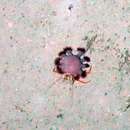en
names in breadcrumbs


The Parapaguridae are a family of marine hermit crabs from deep waters. Instead of carrying empty gastropod shells like other hermit crabs, they carry colonies of dozen or more sea anemones or zoanthids.[2] Some genera, such as Bivalvopagurus and Tylaspis, do not inhabit shells.[3] The following genera are included:[4]
The Parapaguridae are a family of marine hermit crabs from deep waters. Instead of carrying empty gastropod shells like other hermit crabs, they carry colonies of dozen or more sea anemones or zoanthids. Some genera, such as Bivalvopagurus and Tylaspis, do not inhabit shells. The following genera are included:
Bivalvopagurus Lemaitre, 1993 Oncopagurus Lemaitre, 1996 Paragiopagurus Lemaitre, 1996 Parapagurus Smith, 1879 Probeebei Boone, 1926 Strobopagurus Lemaitre, 1989 Sympagurus Smith, 1883 Tsunogaipagurus Osawa, 1995 Tylaspis Henderson, 1885 Typhlopagurus de Saint Laurent, 1972